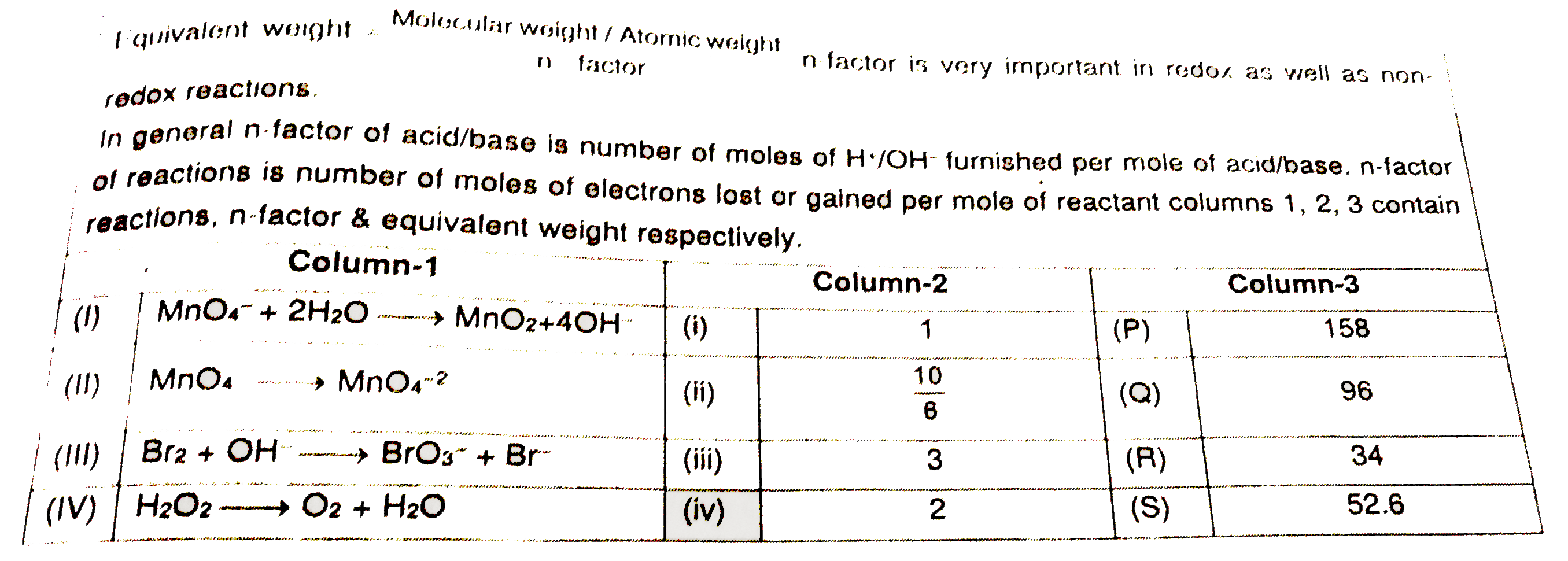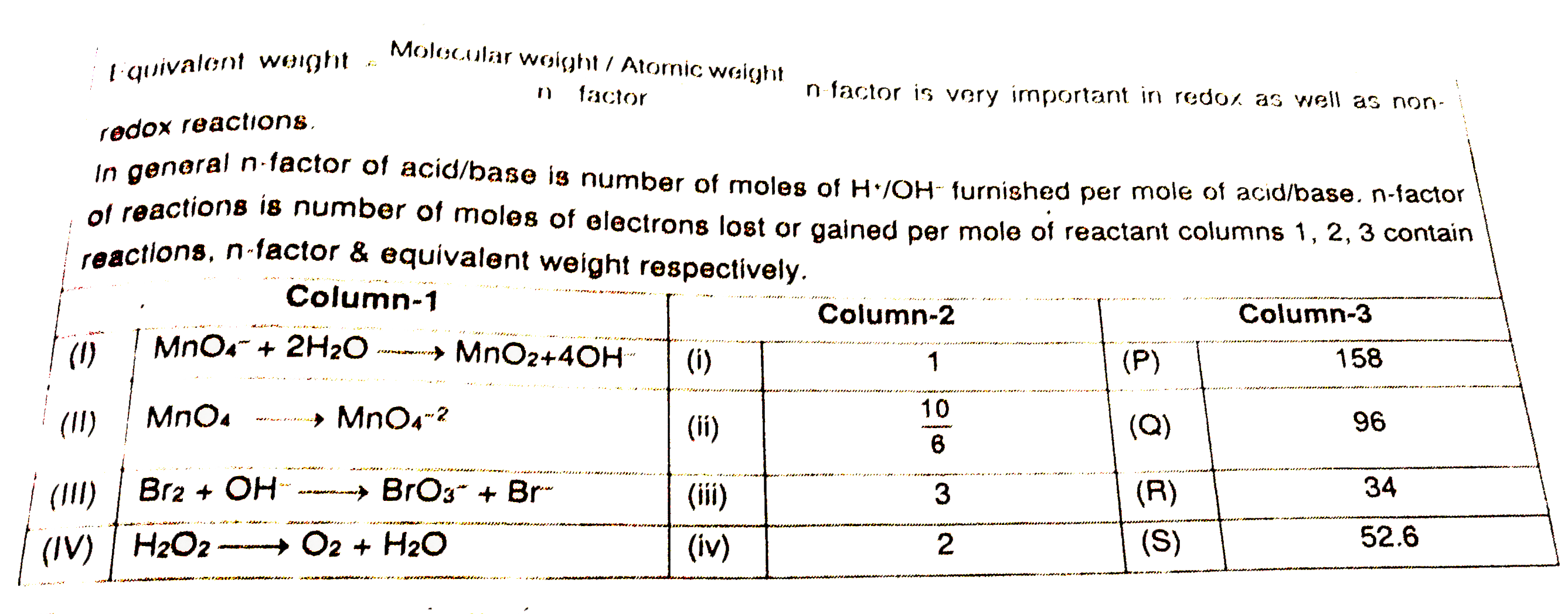Complete Solutions to Exercise -2 (Part-IV) of chapter EQUIVALENT CONCEPT & TITRATIONS of Class 12 book with complete answers and questions
| Class 12 | CHEMISTRY |
| Chapter | EQUIVALENT CONCEPT & TITRATIONS |
| RESONANCE NEW | Exercise -2 (Part-IV) |
| Number Of Questions | 9 |
| Academic Year | 2023-24 |
Equivalent Mass
The eqivalent mass of a substance is defined as the number of parts by mass of it which combine with or displace 1.0078 parts by mass of hydrogen, 8 parts by mass of oxygen and 35.5 parts by mass of chlorine. The equivalent mass of a substance expressed in grams is called gram equivalent mass.
The equivalent mass of a substance is not constant. It depends upon the reaction in which the substance is participating. A compound may have different equivalent mass in different chemical reactions and under different experimental conditions.
(a) Equivalent mass of an acid
It is the mass of an acid in grams which contains 1.0078 g of replaceable `H^(+)` ions or it is mass of acid which contains one mole of replaceable `H^(+)` ions. It may be calculated as :
Equivalent mass of acid=`("Molecular mass of acid")/("Basicityof acid ")`
Basicity of acid = Number of replaceable hydrogen atoms present in one molecule of acid
(b) Equivalent mass of a base
It is the mass of the base which contains one mole of replaceable `OH^(-)` ions in molecules.
Equivalent mass of base=`("Molecular mass of acid ")/("Acidity of acid")`
Acidity of base= Number of replaceable `OH^(-)` ions present in one molecule of the base
Equivalent mass of an oxidising agent
(a) Electron concept:
Equivalent mass of oxidising agent =`("Molecular mass of oxidising agent")/("Number of electrons gained by one molecule")`
(b) Oxidation number concept:
Equivalent mass of oxidising agent=`("Molecular mass of oxidising agent")/("Total change in oxidation number per molecule of oxidising agent")`
Equivalent mass of `Ba(MnO_(4))_(2)` in acidic medium is :(where M stands for molar mass)02:12View SolutionEquivalent Mass
The eqivalent mass of a substance is defined as the number of parts by mass of it which combine with or displace 1.0078 parts by mass of hydrogen, 8 parts by mass of oxygen and 35.5 parts by mass of chlorine. The equivalent mass of a substance expressed in grams is called gram equivalent mass.
The equivalent mass of a substance is not constant. It depends upon the reaction in which the substance is participating. A compound may have different equivalent mass in different chemical reactions and under different experimental conditions.
(a) Equivalent mass of an acid
It is the mass of an acid in grams which contains 1.0078 g of replaceable `H^(+)` ions or it is mass of acid which contains one mole of replaceable `H^(+)` ions. It may be calculated as :
Equivalent mass of acid=`("Molecular mass of acid")/("Basicityof acid ")`
Basicity of acid = Number of replaceable hydrogen atoms present in one molecule of acid
(b) Equivalent mass of a base
It is the mass of the base which contains one mole of replaceable `OH^(-)` ions in molecules.
Equivalent mass of base=`("Molecular mass of acid ")/("Acidity of acid")`
Acidity of base= Number of replaceable `OH^(-)` ions present in one molecule of the base
Equivalent mass of an oxidising agent
(a) Electron concept:
Equivalent mass of oxidising agent =`("Molecular mass of oxidising agent")/("Number of electrons gained by one molecule")`
(b) Oxidation number concept:
Equivalent mass of oxidising agent=`("Molecular mass of oxidising agent")/("Total change in oxidation number per molecule of oxidising agent")`
Equivalent mass of `Fe_(0.9)O` in reaction with acidic `K_(2)Cr_(2)O_(7)` is : (M= Molar mass)02:45View SolutionEquivalent Mass
The eqivalent mass of a substance is defined as the number of parts by mass of it which combine with or displace 1.0078 parts by mass of hydrogen, 8 parts by mass of oxygen and 35.5 parts by mass of chlorine. The equivalent mass of a substance expressed in grams is called gram equivalent mass.
The equivalent mass of a substance is not constant. It depends upon the reaction in which the substance is participating. A compound may have different equivalent mass in different chemical reactions and under different experimental conditions.
(a) Equivalent mass of an acid
It is the mass of an acid in grams which contains 1.0078 g of replaceable `H^(+)` ions or it is mass of acid which contains one mole of replaceable `H^(+)` ions. It may be calculated as :
Equivalent mass of acid=`("Molecular mass of acid")/("Basicityof acid ")`
Basicity of acid = Number of replaceable hydrogen atoms present in one molecule of acid
(b) Equivalent mass of a base
It is the mass of the base which contains one mole of replaceable `OH^(-)` ions in molecules.
Equivalent mass of base=`("Molecular mass of acid ")/("Acidity of acid")`
Acidity of base= Number of replaceable `OH^(-)` ions present in one molecule of the base
Equivalent mass of an oxidising agent
(a) Electron concept:
Equivalent mass of oxidising agent =`("Molecular mass of oxidising agent")/("Number of electrons gained by one molecule")`
(b) Oxidation number concept:
Equivalent mass of oxidising agent=`("Molecular mass of oxidising agent")/("Total change in oxidation number per molecule of oxidising agent")`
Equivalent weight of oxalic acid salt in following reaction is :( Atomic masses:O=16,C=12,K=39) `H_(2)C_(2)O_(4)+Ca(OH)_(2) toCaC_(2)O_(4)+H_(2)O`01:49View SolutionSome amount of "20V" `H_(2)O_(2)` is mixed with excess of acidified solution of Kl. The iodine so liberated required 200 mL of 0.1 N `Na_(2)S_(2)O_(3)` for titration.
The volume of `H_(2)O_(2)` solution is :View SolutionSome amount of "20V" `H_(2)O_(2)` is mixed with excess of acidified solution of Kl. The iodine so liberated required 200 mL of 0.1 N `Na_(2)S_(2)O_(3)` for titration.
The mass of `K_(2)Cr_(2)O_(7)` needed to oxidise the above volume of `H_(2)O_(2)` solution is :View SolutionSome amount of "20V" `H_(2)O_(2)` is mixed with excess of acidified solution of Kl. The iodine so liberated required 200 mL of 0.1 N `Na_(2)S_(2)O_(3)` for titration.
The volume of `O_(2)` at STP that would be liberated by above `H_(2)O_(2)` solution on disproportionation is :View Solution
For `KMnO_(4)` in strong basic medium correct combination is -View Solution
For `KMnO_(4)` in neutral medium correct combination is -View Solution
For a disproportionation reaction the only correct combination is -View Solution
Exercise -2 (Part-IV) questions and complete solutions for chapter EQUIVALENT CONCEPT & TITRATIONS of PHYSICAL, INORGANIC, AND ORGANIC CHEMISTRY of Class 12
All Exercises from RESONANCE NEW Class 12 CHEMISTRY EQUIVALENT CONCEPT & TITRATIONS
- APSP (Part-I)
- APSP (Part-II)
- APSP (Part-III)
- Exercise -1 (Part-II)
- Exercise -1 (Part-I )
- Exercise -1 (Part-III)
- Exercise -2 (Part-I)
- Exercise -2 (Part-II)
- Exercise -2 (Part-III)
- Exercise -2 (Part-IV)
- Exercise -3 (JEE(MAIN) Online problems)
- Exercise -3 (Part-I)
- Exercise -3 (Part-II)
- Miscellaneous solved problems
- Part -IV
- Solved Examples
